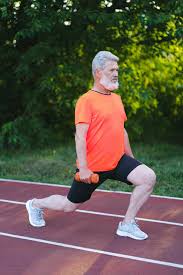6
Section One: The Fundamentals
A) Keywords
Exercise 1:
Provide a brief definition of one of the padlet keywords for this week.
| Anti- aging agenda- The anti-aging agenda is the belief or pressure that people, especially women, should try to stay looking young forever. It often comes from media, beauty industries, and society, telling people that aging is bad or unattractive. This can lead to shame around getting older and a push to use products or treatments to hide age.
|
B) The Social Significance of Aging in Sport
Exercise 2: Notebook Prompt
How is old age popularly represented today? Find an image online that you think exemplifies one defining attitude towards old age and paste in your notebook below with a brief explanation of what this image means to you.

This image shows an older woman sitting on a couch, looking shocked or surprised while holding a TV remote. To me, this image reflects a common stereotype of older people being confused, stuck in the past, or out of touch with the modern world. It exaggerates aging in a way that can seem humorous but also reinforces negative ideas that older adults are helpless or silly. This kind of portrayal can be limiting and disrespectful, especially when it becomes the main way older people are shown in media. I think it’s important to see more diverse and realistic images of aging, ones that show older adults as wise, active, and still full of life. |
Exercise 3: Notebook Prompt
What does the article (referencing another study by Dionigi) mean by its statement that sport can help aging people to simultaneously “accept and resist the ageing process” (572)? Respond by audio or text and find paste two images sourced online into your notebook showing how sport might help aging people to both accept and resist the aging process.
| The article means that sport gives older people a way to both accept their aging bodies and resist the limits that come with age. When older adults play sports, they may feel the changes in their bodies,like moving slower or needing more rest, which helps them accept that aging is natural. But at the same time, staying active and competing helps them push back against the idea that aging means weakness or decline. Sport allows them to show strength, skill, and energy, even in later life. It’s a way to feel proud of what their bodies can do, instead of just focusing on what’s changed.
|
Exercise 4: Notebook Prompt
Who are the groups less likely to have extensive opportunities to take part in sports, according to Pike? How does privilege factor into aging and sport? (200 words max)
|
According to Pike, groups less likely to have many chances to play sports include older adults who are women, people with disabilities, people from low-income backgrounds, and those from racial or cultural minorities. These groups often face more barriers, like lack of money, fewer programs in their communities, or not feeling welcome in sports spaces. Privilege plays a big role in aging and sport. People with more privilege,like those who are wealthier, white, or male, often have better access to sports facilities, time, and support. They can afford gym memberships, equipment, and travel to events. They are also more likely to see people like themselves represented in sports. On the other hand, those with less privilege may not be encouraged to stay active or may feel left out. This can lead to fewer chances to enjoy the physical, mental, and social benefits of sport as they age. That’s why it’s important to make sports more inclusive for everyone, no matter their background or ability.
|
Exercise 5: Padlet Discussion
Why do you think age discrimination is “reported more than any form of prejudice” with older people presented as a threat to social values and interests? Feel welcome to use video in your responses. Paste your comments (or transcript of your video) below!
| Age discrimination is often reported more because society puts a lot of value on youth, beauty, and being fast or productive. Older people are sometimes seen as slow, weak, or not useful anymore. This can lead to unfair treatment or being left out of jobs, sports, or social life. Media often shows older people as grumpy, confused, or needing help, which adds to the problem. Some people may also think that older people take up too many resources, like health care or pensions. This can make them seem like a burden. These negative ideas make it easier for ageism to grow. We need to change how we see aging and show more respect for older adults.
|
B) Older Women and Sport
Exercise 6: Notebook Prompt
What differences do you see in these ads? Which one is more inclusive? How is age represented or not represented in each? Answer these questions in your notebook.
|
After watching both ads, there are some key differences in how they represent people and age. The “This Girl Can – Me Again” ad features real women of different ages, sizes, and backgrounds. It shows them returning to physical activity after life changes like having children or aging. The ad feels personal and honest, highlighting everyday struggles and victories. It sends a message that it’s okay to start again and that movement is for everyone, no matter their age or ability. In contrast, the “Nike – You Can’t Stop Us” ad is fast-paced and features professional athletes from various sports. It focuses on strength, unity, and overcoming challenges. While it includes people from different races and genders, it mostly shows young, elite athletes. Older adults are not visibly represented, and the ad emphasizes high performance over personal journeys. Between the two, the “This Girl Can” ad is more inclusive, especially regarding age. It acknowledges that people of all ages face barriers to exercise and encourages them to participate without judgment. It makes fitness feel accessible and welcoming to everyone
|
Exercise 7: Notebook Prompt
In her article, “Assessing the sociology of sport: On age and ability,” Elizabeth Pike references a “trend towards a ‘feminisation of ageing’, with many women living longer than men” (573). Do you agree that aging has been “feminized” in this way? How? Answer these questions in your notebook.
| Yes, I agree that aging has been “feminized” in some ways. More women live longer than men, so there are more older women in the population. Because of this, aging is often shown or talked about using women’s experiences. For example, media and ads often focus on older women using beauty products to fight wrinkles or looking young. This puts pressure on women to hide signs of aging more than men. Older women are also more likely to face ageism and sexism at the same time, especially in areas like work, health care, and sport. So yes, aging is often seen through a female lens, but not always in a positive or fair way.
|
Section Three: Module Mini Assignment
|
1) Understanding the Problem The “Great Peterborough Pickleball Debacle” highlights a conflict in Peterborough, Ontario, where the rapid growth of pickleball, particularly among older adults, has led to disputes over public space usage. As pickleball courts become more crowded, tensions have arisen between different age groups, with some younger players feeling excluded and older players facing criticism for dominating court time. This situation reflects broader societal challenges in accommodating the recreational needs of an aging population while ensuring inclusive access for all. 2) Media Representation and Ageism Media and social media often portray older pickleball players in a dual light. On one hand, they are celebrated for staying active and social; on the other, they face ageist stereotypes. For instance, a Reddit user shared that younger players often assume older individuals are less skilled, only to be surprised by their proficiency. Ageism manifests when older players are labeled as “old people” engaging in a “gentle” sport, undermining their athleticism. This stereotype ignores the competitive nature and physical demands of pickleball. Moreover, some media narratives suggest that older adults monopolize public spaces, framing their participation as a burden rather than a positive engagement. Elizabeth Pike’s work discusses how neoliberal ideologies promote “successful aging,” emphasizing productivity and self-reliance in older age. Pickleball aligns with this narrative, portraying active seniors as ideal citizens. However, this perspective can marginalize those who cannot or choose not to engage in such activities, reinforcing a narrow view of aging. In summary, while pickleball offers numerous benefits for older adults, media representations often oscillate between praise and ageist critiques. Recognizing and challenging these stereotypes is essential to foster a more inclusive and respectful discourse around aging and recreational activities.
|



